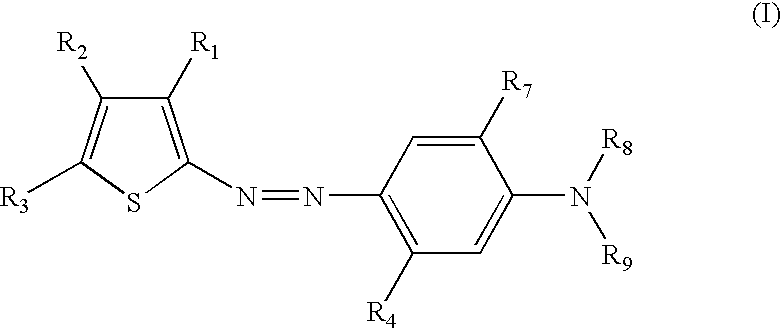Single compound toners for use in polyesters
a technology of single compound and toner, which is applied in the direction of organic dyes, chemistry apparatus and processes, mixing, etc., can solve the problems of unsatisfactory yellowing of polyester fibers and plastics, reduced aesthetics, and compounded yellowing problems, and achieves excellent anti-yellowing results, low extraction, and high brightness (c value).
- Summary
- Abstract
- Description
- Claims
- Application Information
AI Technical Summary
Benefits of technology
Problems solved by technology
Method used
Image
Examples
example 1
The colorant listed as #1 from TABLE 1, above, was produced in accordance with the teachings of U.S. Pat. No. 4,507,407 and kept in a closed container. The colorant exhibited a violet shade and was liquid in nature, with a viscosity level of about 1300 cps at 32 degrees Celsuis.
example 2
14 parts of the colorant from EXAMPLE 1 were then admixed with 2000 parts of CLEARSHIELD® 400, a commercially available UV absorber solution from Milliken & Company. The resultant liquid was a stable homogeneous solution exhibiting a blue color.
example 3
10 parts of the colorant from EXAMPLE 1 were then admixed with 1000 parts of CLEARSHIELD® 390A, a commercially available UV absorber solution from Milliken & Company. The resultant liquid was a stable homogeneous solution exhibiting a blue color.
PUM
| Property | Measurement | Unit |
|---|---|---|
| half-height band | aaaaa | aaaaa |
| wavelengths | aaaaa | aaaaa |
| half-height bandwidths | aaaaa | aaaaa |
Abstract
Description
Claims
Application Information
 Login to View More
Login to View More - R&D
- Intellectual Property
- Life Sciences
- Materials
- Tech Scout
- Unparalleled Data Quality
- Higher Quality Content
- 60% Fewer Hallucinations
Browse by: Latest US Patents, China's latest patents, Technical Efficacy Thesaurus, Application Domain, Technology Topic, Popular Technical Reports.
© 2025 PatSnap. All rights reserved.Legal|Privacy policy|Modern Slavery Act Transparency Statement|Sitemap|About US| Contact US: help@patsnap.com

